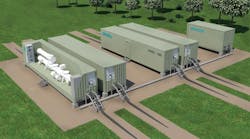High-voltage direct current (HVDC) transmission systems are growing in importance as the radical energy transition alters the landscape for generation, transmission, and distribution of electricity. The power grid comes under pressure with increased emphasis on digitalization, decarbonization, and the resulting growth of distributed generation. It must ensure availability, maintain reliability, and increase flexibility. HVDC technology offers the most efficient means of transmitting a large amount of power over long distances to help connect renewable energy to the grid and stabilize three-phase grids.
A report from 360i Research published early this year predicts that the global market will grow at approximately 11% over the next five years. In particular, the HVDC converter station market accounted for US$8.73 billion in 2018 and is predicted to reach US$21.44 billion by 2027.
Need for HVDC
The quickening transition from fossil fuels to renewable resources is required to fulfill the Paris Agreement’s obligations and is having a powerful effect on load flows. To cope with increased loads, significant improvements to the existing power transmission infrastructure are required. Apart from increased loads, the new network must also deal with transmitting power over increased distances between power generation and load centers. When you add the market forces from the emerging international electricity markets that need increased transmission capacities with enhanced cross-border interconnectors, it is a system in change and in need of reinforcement.
Increasing loads along routes while maintaining optimum performance by minimizing loss in a network is crucial, and this is where HVDC comes into play. Whenever power is transmitted over long distances, high-voltage dc transmission is the most economical solution compared with high-voltage ac transmission.
Need for renewables
One significant driver of HVDC technology is the growing need to integrate renewable resources into the grid. As these resources are often located away from load centers, and in the case of offshore wind farms, remote from the grid itself, an HVDC connection is an optimum solution. The trend for offshore wind is undoubtedly growing, with 160 offshore turbines totaling 1.1 GW added to the German grid last year. According to plans drafted by the federal government, offshore wind capacity is expected to reach 15 GW by 2030.
Getting power to load centers
Integration of renewables and also network stabilization requires the benefits that HVDC can deliver. In Germany, there are plans to build a North-South connection, called SuedLink, as part of a broader program to increase the flow capacity between Northern and Southern Germany and facilitate the integration of renewable energy into the grid. This project will also avoid spillovers caused by surges in generation in parts of Germany into the grids of neighboring countries such as Hungary, Poland, the Czech Republic, and Slovakia. This line will be constructed using HVDC technology that will allow network stabilization for the high fluctuation in energy generation, including an optimized load flow to balance the meshed 400-kV ac network. The planned HVDC transmission lines will mainly be realized by underground dc cables using ±525 kV.
This line will include HVDC converter stations to add control to power flow. Depending on the type of converter circuits, the power can be transferred into capacitive or inductive power, or the power flow can be reversed. These features of HVDC converters will be used for future overlay networks worldwide.
For interconnects, transition stations are required after a certain length of the cable installation to provide separation and safe earthing of each line section, for energizing and commissioning tests, and for physical separation of cables from different suppliers. These cable-to-cable transition stations may include disconnector and earthing switches, devices for voltage and current measurement, and line-fault location. At the same time, overhead line to cable transition also includes surge arresters.
Gas-insulated switchgear
In the growing raft of applications for HVDC systems, space is a highly valued commodity — whether it be on offshore wind farms, HVDC solutions for highly populated areas, or even transition stations on interconnects. When it comes to space-saving technologies in high-voltage power transmission, one of the most effective tools is a gas-insulated switchgear (GIS) instead of an air-insulated switchgear (AIS).
As it is valid for every new technology, there were some challenges with respect to the dc application that needed to be considered during the development of a dc GIS. In the end, newly developed insulation technologies for dc, comprehensive investigations, and the experience of Siemens Energy allowed the company to successfully adapt the proven 8DQ1 gas-insulated ac switchgear technology for high-voltage dc applications of up to ±550 kV and currents of up to 5000 A. The space-saving potential of GIS is significant as the space requirements for the switchyard can be reduced by up to 95% in contrast to AIS.
GIS technology for dc applications has been investigated since the 1980s with few applications worldwide. In the last decade, development programs in Asia and Europe have made significant progress in basic knowledge of dc gas-insulated systems, resulting in new technical solutions.
Dc GIS technology has already been put into operation as part of commercial projects in Japan, for example, the Kii Channel Link, commissioned in 2001, and the Hokuto Converter Station, commissioned in 2019. There are more projects to come in Europe — DolWin6 and BorWin5 mark the sixth and seventh HVDC offshore grid connection project undertaken by Siemens Energy in the German North Sea, both using dc gas-insulated systems. DolWin6 and BorWin5 are both scheduled to go into operation in 2023 and 2025.
A new approach required
Compared with AIS, the gas-insulated design of HVDC systems for converter and transition stations offers various benefits to operators. This is especially true where space-saving installation, aesthetic station layout, independence from environmental conditions, and the avoidance of transient interference caused by lightning strikes are required.
Compact GIS assemblies for HVDC applications have been developed and are currently entering the market. Gas-insulated systems, in general, feature a high degree of reliability and excellent long-term performance. An intrinsic difference between ac and dc is, however, that the electric conductivity of insulation materials that is determining a dc electric field is strongly temperature-dependent, while their permittivity determining an ac electric field is not varying in the respected temperature range. Subsequently, dc specific aspects must be considered during development and proven in suitable tests.
The specification for dc GIS has some significant differences to its well-established ac sibling, as dc insulators are exposed to the phenomenon of field transition accompanied by charge accumulation in the bulk and at the insulator interfaces. After energization the electrostatic field, determined by permittivity, is transformed with time into the electric flow field which is determined by the conductivities.
The resulting resistive field distribution strongly depends on the materials used and their temperature- and electric field-dependent conductivities. Heat conduction, radiation, and gas convection caused by the current in the conductor lead to a temperature gradient during operation. The resulting temperature gradient across the insulator from the conductor toward the enclosure causes increased material conductivities in the warmer material close to the conductor. Accordingly, the highest electric field stress drifts toward the colder regions at the enclosure.
Because of this temperature-dependent dc field distribution, appropriate materials and reliable electric field control are essential. The reliability of the 8DQ1 dc GIS under various load conditions and electrical and thermal stress has been proven in type tests, according to applicable IEC standards for similar ac technology and CIGRE recommendations for dielectric testing of gas-insulated HVDC systems.
Since 2014, recommendations have been developed by the CIGRE JWG D1/B3.57–Dielectric testing of gas-insulated HVDC systems. In principle, the electrical and mechanical requirements, according to IEC 62271-203, which are independent of the type of operating voltage, must be fulfilled. Additional electric and thermoelectric tests must consider unique aspects of dc voltage application.
Type approval test with dc cable
Another important feature of dc GIS is the interface modules required to enable the transition from GIS to other equipment, such as an overhead line or a dc cable. A recent advancement came with the successful completion of the world's first type approval test on its 525-kV dc cable system with a dc GIS interface in accordance with IEC 62271-209 and CIGRE TB496.
Together with Sumitomo Electric Industries and Südkabel, Siemens conducted a type approval test at Mannheim laboratories of KEMA Labs, a CESI brand in Germany. The integrated cables were insulated with an advanced XLPE compound, developed for polarity reversal operations by Sumitomo Electric Industries. They have been manufactured at two different locations. The first cable has been manufactured at Südkabel GmbH in Mannheim, Germany, whereas the second cable has been manufactured by Sumitomo Electric Industries in Hitachi, Japan.
Thanks to the higher insulation capacity, the direct combination of the insulation systems of the dc GIS and the cable requires remarkably less space than the alternative air-insulated system. Thus, this powerful combination can help transmission system operators overcome space challenges, often found in projects with offshore (and onshore) converter stations or transition stations.
Looking ahead
In an energy landscape driven by the worldwide increasing demand for electrical energy and a global call for decarbonization, multiterminal dc interconnectors will be needed to ensure a reliable and sustainable energy supply. When it comes to HVDC cable lines to offshore converter platforms and onshore transition stations, a dc GIS provides a compact and efficient solution with high functionality.
The successful type test has proven the conformity of Siemens Energy's dc GIS and a 525-kV dc cable system, according to latest international cable system tests requirements. It once again underlines the future-oriented design of a dc switchgear — especially when it comes to challenging space requirements — and can be added to the list of benefits of dc gas-insulated systems.





